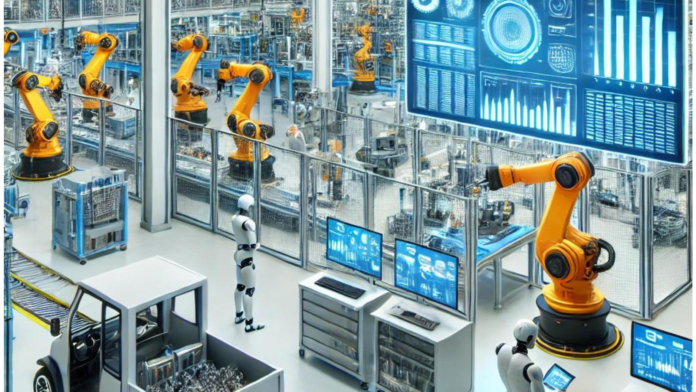In the past few decades, manufacturing has undergone a radical transformation. From the first industrial revolution powered by steam engines to today’s high-tech factories filled with robots, automation has been the driving force behind many of these changes. As industries continue to evolve, automation is increasingly being recognized as a game changer in the manufacturing sector. The integration of automated technologies such as robotics, AI, and IoT is revolutionizing production processes, enhancing efficiency, and boosting competitiveness across industries.
In this article, we’ll explore how automation is changing manufacturing, the technologies behind it, and the benefits and challenges that come with this transformation.
What is Automation in Manufacturing?
Automation in manufacturing refers to the use of technology to perform tasks that were once done manually, allowing for more efficient and precise production processes. This includes the deployment of machines, robotics, software systems, and AI to handle various stages of production, from assembly to quality control. Automation can range from simple tasks like packaging to complex operations such as monitoring and optimizing entire production lines.
Key Automation Technologies in Manufacturing
Several cutting-edge technologies are driving automation in the manufacturing industry. These include:
1. Robotics
Robots have been a cornerstone of manufacturing automation for decades, but recent advancements have made them more versatile and intelligent. Industrial robots are now capable of handling a wide range of tasks, from assembling intricate electronic components to welding car parts. Collaborative robots, or “cobots,” are designed to work alongside human workers, improving productivity while maintaining safety.
2. Artificial Intelligence (AI) and Machine Learning
AI and machine learning are transforming manufacturing by enabling machines to learn from data and improve their performance over time. AI-powered systems can predict maintenance needs, optimize production schedules, and ensure quality control with minimal human intervention. In some cases, AI can identify inefficiencies in the production process and make adjustments in real-time, improving both productivity and cost-efficiency.
3. Internet of Things (IoT)
IoT connects devices and machinery in a factory, creating a network of smart equipment that communicates in real-time. This allows manufacturers to monitor and control production lines remotely, reducing downtime and optimizing equipment usage. IoT sensors can track everything from temperature to machine performance, providing valuable insights into how the production process can be optimized.
4. Automated Guided Vehicles (AGVs)
AGVs are autonomous vehicles used to transport materials within a factory. These vehicles follow pre-programmed paths or navigate using sensors and cameras, eliminating the need for human intervention in material handling. AGVs are commonly used in large-scale manufacturing environments like automotive plants and warehouses.
5. 3D Printing (Additive Manufacturing)
Automation is also being driven by advancements in 3D printing, which allows manufacturers to create complex parts directly from digital designs. 3D printing automates the production process by eliminating the need for multiple steps in traditional manufacturing, such as molding and casting, and enables rapid prototyping, reducing lead times.
The Benefits of Automation in Manufacturing
The adoption of automation in manufacturing has led to a wide range of benefits, making it a game changer for the industry. These benefits include:
1. Increased Efficiency and Productivity
Automation allows manufacturers to operate 24/7, without the need for breaks or rest. Machines can work faster and more accurately than humans, leading to significant increases in production speed. Automated systems can also handle repetitive tasks with greater precision, reducing errors and rework.
2. Cost Reduction
By automating processes, manufacturers can reduce labor costs and minimize waste. Automated systems are capable of optimizing the use of raw materials, ensuring that only what is needed is consumed, thereby cutting down on excess. Additionally, predictive maintenance enabled by AI can reduce the likelihood of costly equipment breakdowns.
3. Improved Quality Control
Automation ensures consistency in production, which leads to higher-quality products. Machines are less prone to errors than human workers, and automated quality control systems can inspect products more thoroughly and accurately. This ensures that defective products are identified and removed from the production line before they reach customers.
4. Enhanced Safety
By automating dangerous or repetitive tasks, manufacturers can reduce the risk of workplace accidents. Robots and automated systems can handle hazardous materials, heavy lifting, and other tasks that would be risky for human workers, creating a safer work environment.
5. Flexibility and Scalability
Automated systems can be easily adjusted to accommodate changes in production needs. For instance, if demand for a product increases, automated machinery can ramp up production without the need for additional labor. This flexibility is particularly valuable in industries where production volumes fluctuate.
Challenges of Implementing Automation
While automation offers numerous benefits, there are also challenges that manufacturers must address when implementing these technologies:
1. High Initial Costs
The upfront investment in automation can be significant. Purchasing robotics, AI systems, and IoT devices, along with the software to manage them, requires substantial capital. However, for many companies, the long-term savings in labor and operational efficiency outweigh the initial costs.
2. Workforce Displacement
One of the most widely discussed challenges of automation is its impact on employment. As machines take over tasks that were previously performed by human workers, there is a risk of job displacement, particularly for low-skill workers. However, this also creates opportunities for reskilling and upskilling, allowing workers to transition to roles that require more technical expertise in managing and maintaining automated systems.
3. Integration with Existing Systems
Many manufacturers still rely on legacy systems that may not be compatible with new automated technologies. Integrating new systems with old infrastructure can be complex and costly, and businesses must carefully plan their transition to automation to avoid disruptions in production.
4. Cybersecurity Risks
With the increasing use of IoT and connected devices in manufacturing, cybersecurity becomes a critical concern. Automated systems are vulnerable to hacking and data breaches, which could disrupt production or compromise sensitive company data. Manufacturers must invest in robust cybersecurity measures to protect their operations.
The Future of Automation in Manufacturing
The future of automation in manufacturing looks promising, as advancements in AI, robotics, and IoT continue to accelerate. Factories are expected to become increasingly “smart,” with machines that can communicate, learn, and adapt in real-time. This will lead to even greater efficiency, flexibility, and innovation in the manufacturing sector.
Moreover, the concept of “Industry 4.0” is gaining traction, referring to the fourth industrial revolution, which focuses on the integration of automation, data exchange, and advanced manufacturing technologies. In an Industry 4.0 environment, machines will not only perform tasks but also make decisions, collaborate with other machines, and optimize the entire production process autonomously.
Conclusion
Automation is undoubtedly a game changer in manufacturing, offering unprecedented opportunities to enhance productivity, reduce costs, improve safety, and deliver higher-quality products. While there are challenges to overcome, including the initial investment and the need to address workforce displacement, the benefits of automation far outweigh the drawbacks.
As technology continues to advance, automation will play an increasingly critical role in shaping the future of manufacturing. Companies that embrace this transformation and strategically implement automation solutions will gain a competitive edge in the global market, setting the stage for a new era of innovation and growth in the industry.














